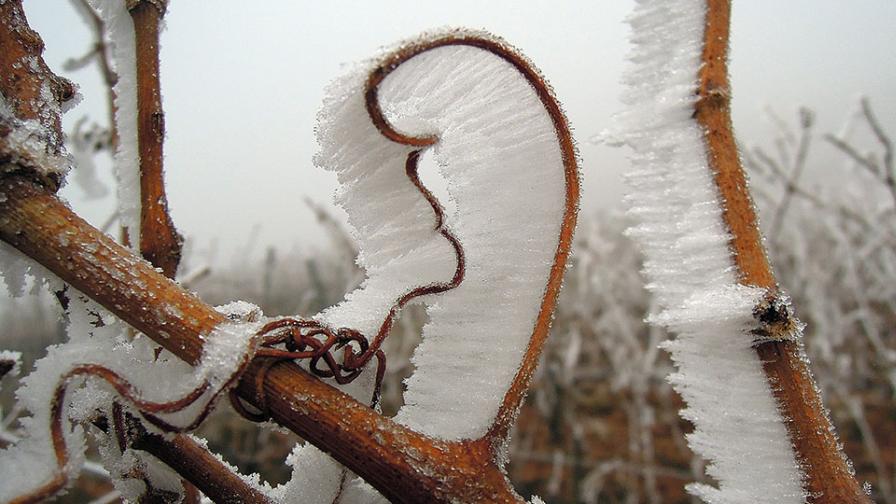How the Right Vineyard Equipment Can Help Bring the Heat Against Frost

Hoar frosts account for more than 90% of all frost events in the Southeast, often indicated by water crystals forming on surfaces.
A vineyard is almost defenseless against a hard freeze, according to Mark Hoffman. But grape growers in the Southeast U.S. do have a fighting chance against frosts, the Small Fruits Extension Specialist at North Carolina State University adds, thanks to protection methods such as wind machines and sprinklers.
Freezes, which are advective, typically occur in the winter or early spring before bud break. Fortunately, the Southeast has not experienced a major spring freeze since 2007. Entire vine structures were damaged, in part because sprinklers and wind machines typically do not help with freezes, Hoffman says.
“Most active frost protection methods only work under inversion conditions,” he says.
Late-spring frosts, between mid-April and early May, are also dangerous and common, Hoffman says. Characterized by clear nights and wind speeds less than 5 mph, they occur every four to five years in the Southeast, he estimates.
“They affect buds,” Hoffman says. “But active protection can help.”
Hoffman stresses that growers must focus on plant tissue temperature rather than air temperature. The critical temperatures for grape buds, representing 10% kill and 90% kill, respectively, are: first swell (13°F, minus 3°F), full swell (26°F, 10°F), bud burst (28°F, 16°F), first leaf (28.5°F, 21°F), second leaf (29°F, 22°F), third leaf (28°F, 26°F), and fourth leaf (28°F, 27°F).
Growers who are intent on preventing frost injury should focus from the get-go on field sites and cultivars, Hoffman says. Sites that frequently show frost on grass, vegetation, or other structures should be avoided, as they usually do not experience very good airflow. Early bud-breaking cultivars are also discouraged.
Meanwhile, growers with established vineyards can turn to several active frost management methods.
WIND MACHINES
Wind machines mix the warmer air above the height of the inversion layer with the colder air near the ground and remove the coldest air close to leaves, replacing it with warmer ambient air.
“They are highly dependent on the inversion weather situation,” Hoffman says, noting that wind machines should be used only during frost occurrences when wind speed is less than 5 mph. Freeze and frost/freeze situations exceed that speed.
Machines cover between 8 and 10 acres of vineyard, depending on the terrain and vineyard layout. They can be either portable or permanently installed and should not be confused with wind turbines that are used to generate electricity. Wind machines have tall fans that are driven by propane, gasoline, or electric engines. The cost of a machine is $20,000 and higher, Hoffman says. A weather station should be installed in the vineyard, he adds, and online agricultural weather services, such as an AWIS (Automatic Weather Information Service), should be consulted frequently to better predict the use of wind machines.
OVERHEAD SPRINKLER SYSTEMS
Frost protection with over-vine sprinklers requires maintaining a continuous water/ice interface and an undisturbed tissue/ice connection. To achieve this, Hoffman says, water needs to be supplied constantly, starting at dusk until temperatures are high enough for the ice to thaw. This will build up a layer of ice over the tissue. Constant application of water will keep the ice temperature around 31°F or 32°F, slightly above critical levels for damage to buds and shoots.
Using sprinkler systems to protect leaf and bud tissue from frost injury requires consistent droplet size and coverage. Also necessary are large water sources, high-capacity pumps, reliable operation in cold temperatures, fast sprinkler head rotation times, and high uniformity in droplet size and distribution patterns, Hoffman says.
OTHER METHODS
There are several other active measures of frost prevention, including the use of helicopters to move air from the invers-ion zone into the vineyard, the use of hot stones or heaters to supply hot air in a vineyard, and the use of fans in lower elevations to move warmer air to the vineyard.
The use of vineyard fires is only recommended if users are fully aware of the risks, Hoffman says. “Vineyard fires are very labor-intensive and can cause severe damage to a vineyard if not handled properly,” he says.










